First Look: Pier 26
At last night’s meeting of the Community Board 1 Tribeca Committee, the Hudson River Park Trust presented an initial plan for Pier 26, the unfinished pier between N. Moore and Hubert. They called it a “concept design,” but they also said that they’re hopeful construction will start a year from now, so must mean this design is pretty far along. “We have all the money for this, and I don’t get to say that very often,” said HRPT president Madelyn Wils. The city, Lower Manhattan Development Corporation, and Citigroup each contributed $10 million. “What does Citi get out of this, if naming rights aren’t an option?” asked a committee member after the meeting. We shall see….
Before we get into it, bear in mind that the presentation did not include the estuarium building, shown in the rendering below as a placeholder on stilts in the upper left corner; most of the pier is being designed by Olin Studio, but that building will be by Viñoly. My sense is that the more granular you get about the design, the less likely it is to be firm; the big takeaway here is how the pier will be carved up and used. (All of the visuals here are by Olin Studio.)
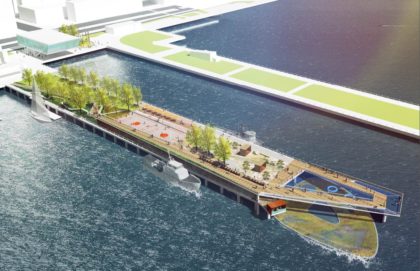 The pier can be thought of as divided into sections.
The pier can be thought of as divided into sections.
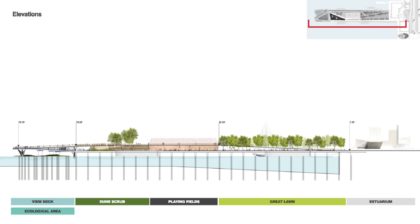 The River Esplanade (which rises as you head west, and then loops back under itself). At its peak, the elevated walkway is 12-16 feet above the water, depending on the water level.
The River Esplanade (which rises as you head west, and then loops back under itself). At its peak, the elevated walkway is 12-16 feet above the water, depending on the water level.
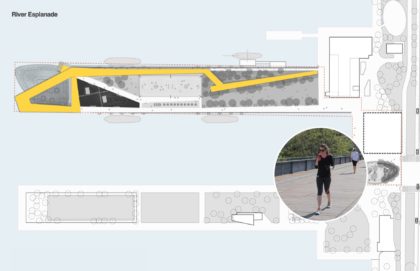 The first part of the esplanade passes through a Forest Walk area. For each of these areas, the presentation included a diagram slide (with an inset photo meant to show the inspiration, not the finished look), followed by a rendering or two:
The first part of the esplanade passes through a Forest Walk area. For each of these areas, the presentation included a diagram slide (with an inset photo meant to show the inspiration, not the finished look), followed by a rendering or two:
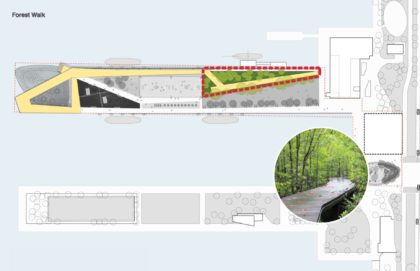
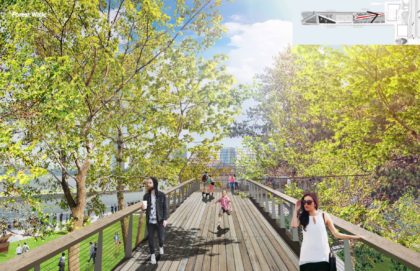 The Lounge Deck and Estuary Lounge Steps:
The Lounge Deck and Estuary Lounge Steps:
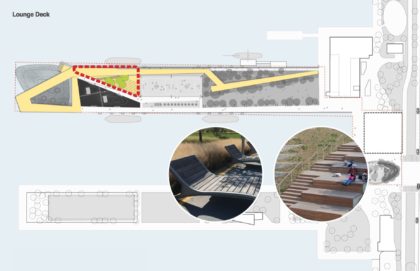
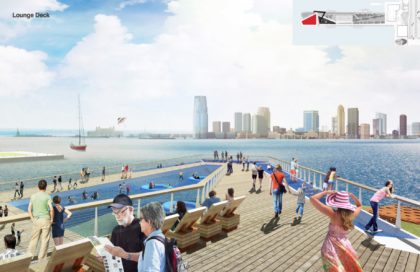
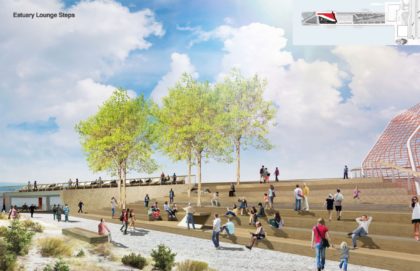 For the Lounge Nets and Play Nets, they’re looking at a metal mesh that would be open to the water below (but realizing they may have to add a fine net underneath, for cell phones and other lost property). The blue rings are for seating.
For the Lounge Nets and Play Nets, they’re looking at a metal mesh that would be open to the water below (but realizing they may have to add a fine net underneath, for cell phones and other lost property). The blue rings are for seating.
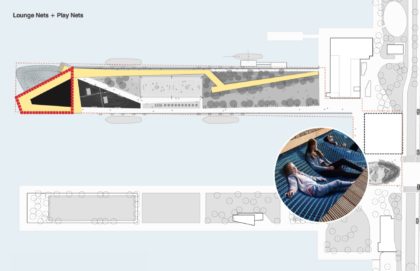
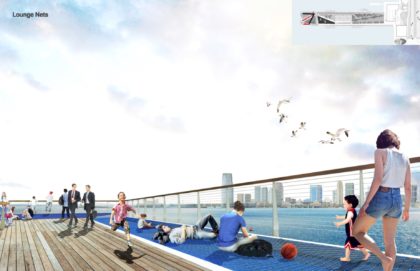
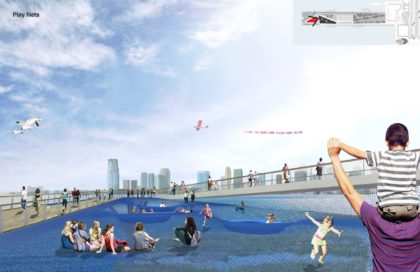 They were excited about the view toward 1 World Trade Center, but it seems like what you can already see from Pier 25.
They were excited about the view toward 1 World Trade Center, but it seems like what you can already see from Pier 25.
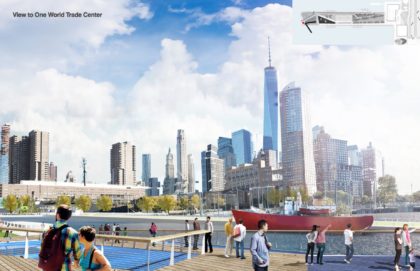 The tip, where the walkway dips down and around the net.
The tip, where the walkway dips down and around the net.
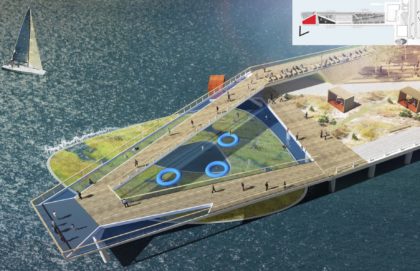 The elevation shows it more clearly:
The elevation shows it more clearly:
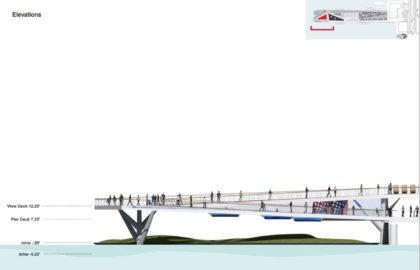 They’re hoping to create a wetlands at the end, on the water, but it will require approvals from many other organizations and agencies.
They’re hoping to create a wetlands at the end, on the water, but it will require approvals from many other organizations and agencies.
The Dune Scrub, on the south side, will be fairly dry landscaping. The open-sided structures are for sitting in—perhaps swings, or just boxes:
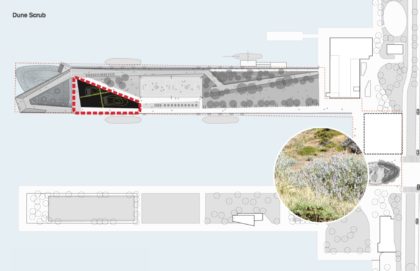
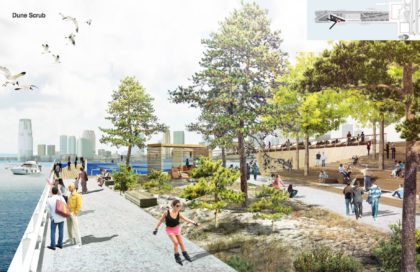 And there’s a trapezoidal lawn, meant to be used for various activities or just lounging:
And there’s a trapezoidal lawn, meant to be used for various activities or just lounging:
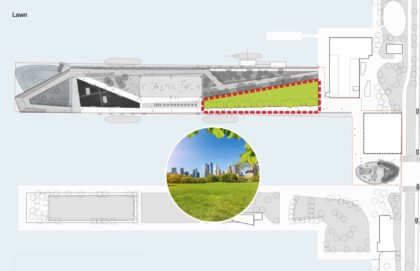
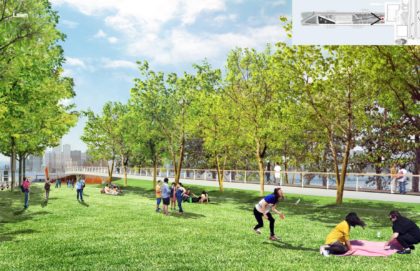 An aerial (not sure why this was in the middle of the presentation, but it’s interesting):
An aerial (not sure why this was in the middle of the presentation, but it’s interesting):
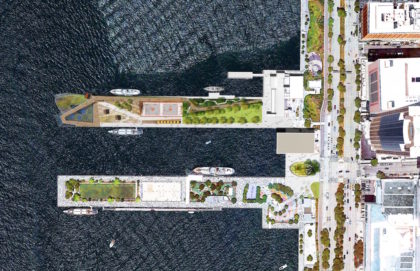 The recreation fields, which will probably be made with interlocking rubber pieces:
The recreation fields, which will probably be made with interlocking rubber pieces:
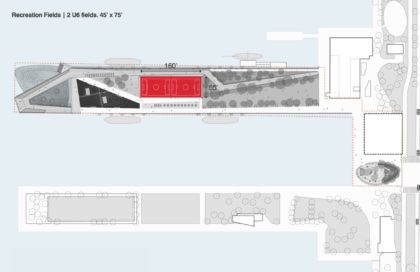 The evacuation route, which affects where things can be laid out:
The evacuation route, which affects where things can be laid out:
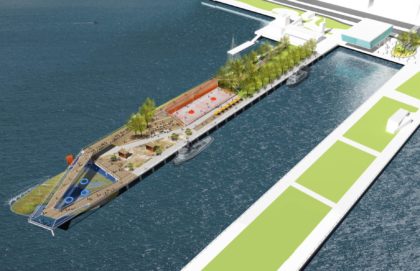 And that’s it. I need to run out for a bit, but I’ll go through my notes again when I’m back to see if I missed anything.
And that’s it. I need to run out for a bit, but I’ll go through my notes again when I’m back to see if I missed anything.
UPDATE: A few items of note….
1. Access to the boats docking on the north side, including the Clearwater (which hosts educational programs), will be on a level below the elevated esplanade. The Downtown Boathouse is not happy about having to cope with boats near its kayaking area, and Mary Habstritt of the Lilac, on Pier 25, noted that many boats sit too low in the water near the pier, which is only eight to ten feet deep. (“We’re often siting in the mud,” she said.)
2. There will probably be interpretive signage about the estuary.
3. A committee member asked the HRPT’s Madelyn Wils whether there were any plans to sell the pier’s air rights, but there are currently no properties in Community Board 1 that could legally buy them. That “currently” is important: Another committee member pointed out that the BMCC complex is not currently zoned at all, and if that changed, the air rights could make a massive project even bigger. Wils said that were such a development to happen, the Trust would prefer to benefit from it (versus not benefiting at all).







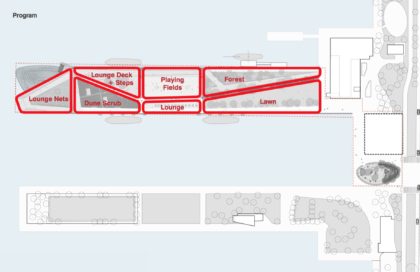
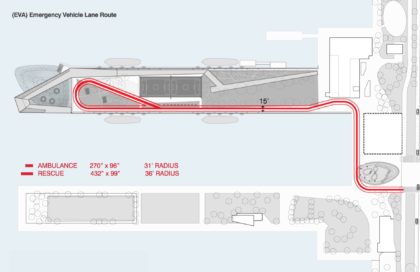
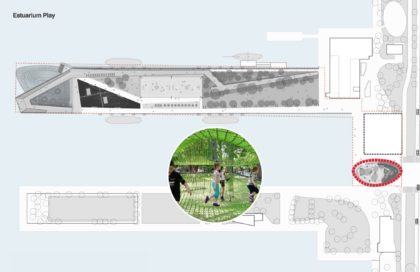
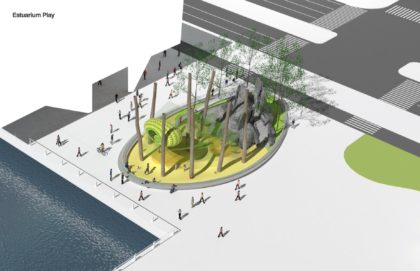
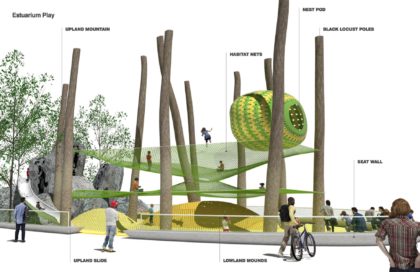






Looks Great! thanks for all of the info along with the pictures.
Totally awesome ! Can’t wait to see it built
Beauty out my window!
I find his to be a sad design that could be an equal-sized park somewhere on land. Its “forest”, play space, “dune” grassland, etc., avoid engaging the living, changing river in a meaningful way. Despite the inclusion of an ambitious pier-end steel mesh “lounge”, the overall design focuses on a program of uses and urban park conventions, rather than this unique “place”. Aside from its existing views of the sky and river-sweep, most of it could be located within the buildings of Battery Park City, or in Philadelphia.
What is this place?
This river is alive. It is an immense complex of tidal, seasonal, and weather-related events — and human activity — that profoundly influence the water and the creatures that live in it. It is based on water-born plants and animals that sustain all life on earth. The nature of the Estuary is as fascinating and profound – and hidden – as any place in nature.
Mere blocks from the World Trade Center and its diverse memorials, Pier 26 can offer an intimate encounter with the intelligence in nature if we provide a means to observe it. It can help remedy our increasingly over-designed City and our collective need for greater ecological awareness in a time of rapid species depletion and perilous climate change. These are needs that will only increase in the years ahead.
The Estuarium should be the focus of Pier 26 and should be located upon it and well offshore, with ample deck and dockside space to enable the netting, collecting and study, dive support and small boat use, water sampling and other research activities that are part of an exciting marine research and education program that engages the public. The Clearwater should be part of this program.
Think Woods Hole.
To reveal the intense life and ecology of this place, river water should be pumped up to deck-level to flow through aquarium tanks that display river creatures and how they interact with one another and with the brackish tidal water that changes day to day and hour to hour.
The River Project pioneered this Estuarium concept on Pier 26 in 1986 on a shoestring budget, and helped to establish the Hudson River Park Estuarine Sanctuary that now extends to 59th Street. There is no other program in New York or in the world that offers such an intimate and in-depth experience of the living environment in such close proximity to its urban setting.
Olin’s concept design locates the Estuarium in a box next to a noisy highway and a fantasy playground that offer little contact with the water. Their pier and pathway offer a series of encounters with artificial landscape zones that are largely a repeat of the adjacent Pier 25.
None of these experiences provide a view of the life beneath the water’s surface, nor any insights about what is hidden in this place. Why limit our vision to a conventional list of park amenities on Pier 26 that repeats what is available nearby in the Park and ignores the potential to connect with the gigantic living space that surrounds it?
Out on the pier’s end, surrounded by water, it may be that walking or sitting on an open-mesh surface 10-15 feet above the water will provide a physical thrill and a memorable encounter with the water’s surface action. Given this river’s nature, this may rarely be restful or likely to invite a person to linger. Visitors can already observe this on the open meshes of the East River Park at Wall Street.
A restless tendency may be especially true above an artificial wetland, if we are to imagine the oyster shoals, insects, floating trash and periodic effluents that are natural to this location.
I hope that all the designers and stakeholders that are involved in this worthy project will recognize that Pier 26 represents an opportunity for the public to encounter the living river above and below the water’s surface and a legacy for future generations that we cannot squander on a conventional menu of urban park amenities. There will never again be such an opportunity to access the life in this location which is so important to New York City and the world.
Thank you for so beautifully stating a vision for this park that centers on the ecology of the river. I remember the old estuarium and I hope that the River Project will be able to have a new home here. I agree, although this is a nice park, it does miss a great opportunity to be something more, something that embraces the life and mystery of the Hudson and the Hudson River Park Estuarine Sanctuary.
Another thank you for your articulate post. The plan is too theme park-y and over-designed, and probably very expensive to maintain, when something simpler and more connected to the river would be appropriate. +1 for the return of the River Project to the pier and a better sense of the river.
The ambitions of an ecological pier are admirable however there is immense pressure for Pier 26 to serve the needs of the Tribeca neighborhood with a growing population of young families and children.
Unfortunately, Pier 26 is incapable of structurally holding a building, hence why it is on the land side. The coordination and maintenance costs of water being pumped onto the Pier for education purposes would be in the hundreds of thousands per year. The budgets of HRPT and Clarkson preclude such ambitious pursuits.
OLIN’s design, while a bit over-programmed, is necessary to meet the needs of a broad range of users. The wetland at the end of the Pier, while not an ideal location from a water habitat and edge condition perspective, is in the historic 150′ easement of the Pier and DOES NOT require any permitting from the Army Core of Engineers and other Federal and State regulatory commissions.
The wetland will be the first of its kind in the Hudson River and will serve as a dynamic and visible education opportunity. It will inform us about estuarine ecology, rising sea levels and the relationship between urban and ecological systems.
Very interesting plans, indeed. Hope the money and ideas come together.
You might want to consider the effects of ice floes on the lower levels of Pier 26.
Only a decade or two ago ice routinely covered much of the embayment in winter and could again — in future — potentially cause tidal ice damage to the more fragile structures envisioned for Pier 26.
The Civil Service Bookshop formerly in Tribeca for over 60 years, was forced to relocate to the West Village due to construction hazards surrounding the store from adjacent properties. Now the book shop is sharing a store at 34 Carmine Street, N.Y.